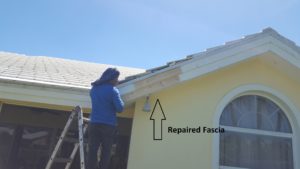Rotten Fascia and Soffit Repair
 The soffit is the exposed siding underneath the roof’s overhang. Fascia is the area of siding directly above the soffit. It’s the exposed board seen on the front of the roof’s overhang.Just like soffit, fascia can be made of aluminum, wood or vinyl. The gutters are also placed in the fascia
The soffit is the exposed siding underneath the roof’s overhang. Fascia is the area of siding directly above the soffit. It’s the exposed board seen on the front of the roof’s overhang.Just like soffit, fascia can be made of aluminum, wood or vinyl. The gutters are also placed in the fascia
The soffit is important because it has venting that helps keep a steady airflow between your roof and attic. The attic needs to be well ventilated or else moisture can build up causing mold to develop.Aside from keeping moisture out, soffit helps release heat from your attic during the hot summer months, and keep animals and insects out of your home. It’s important to make sure your soffit has no cracks or holes in it and if it does, you must repair or substitute it right away.
Fascia consists of the long straight board along the lower edge of the roof because it’s the last line of support for the lower edge of the bottom row of roof tiles or shingles.Plus, it’s what your gutters are installed on. Gutters are extremely vital and the fascia needs to be able to hold them up even during a torrential downpour.
The location of fascia and soffit are close the roof envelope outside of the structure’s walls. This means that they are the first things to be damaged by water if the home’s gutters become clogged or a leak in the roof develops. In addition, they can also fall victim to an infestation of insects or nesting birds and other animals. If you have noticed a discoloration and peeling paint, it can be a sign that the soffits and fascia on your home have been damaged.
Rotted Fascia Repair
Physically, fascias are the trim boards at the edge of the roof of a house. There are two types of the fascia. Rake fascia is fascia at sloped ends of a house or under a gable and eaves fascia is horizontal fascia that covers the ends of rafters. Typically all fascia trim is vulnerable to decay, especially if the roof is poorly constructed.
Repairing rotten eaves fascia generally consists of replacing the damaged boards but is much more complicated than one might think. This is because the roof metal flashing that covers the top of the fascia (called drip edge) must be taken off to access and remove the fascia.
If the removal of the fascia without removing the drip edge, the metal drip edge will get bent and damaged. This is not good for the house appearance. So, what needs to do is the roofing above the drip edge needs to be removed first. Thus, replacing damaged fascia inherently includes a roof repair above the fascia.
This method or strategy is probably is the best wat because commonly the rotten fascia is almost always caused by a leak in the roof above the rotten board that is unseen. As consequences, if the fascia is replaced without repairing a roof leak above, the fascia will become rotten again.
To identify rotted fascia is fairly easy, by searching peeling paint, stains, crumbling wood and loose gutters. If it made from wood, the decayed wood crumbles easily and usually look like it going to fall off. Whereas fascia covered by aluminum or vinyl siding is harder to check. The metal is called cladding. One problem with such siding is that it can hide decaying wood until the condition is too advanced to repair easily.
Rotted Soffit Repair
Whatever the material of soffits, either constructed of wood, stucco, vinyl or metal closures, it’s really essential to have a soffit in good shape. A well-constructed soffit keeps animals and bugs out. It also protects the roof from wind damage during hurricanes.
Soffit eaves and gable overhangs are vulnerable to water damage caused by improper flashing, torn shingles, cracked tiles, faulty gutters and roof leaks above. Once water gets in, the rot spreads rapidly because the wood stays soggy in the dark attic space.
Another thing that causes broken or rotted soffit is damage by birds, squirrels and insects nesting inside eaves. These animals have been known to chew or peck through a perfectly sound eave, but they’re especially attracted to a water-damaged fascia or soffit, which offers less resistance. Bees and hornets also build nests in and under eaves. In this situation, it is better to contact an exterminator if bees or hornets are seen nesting in the soffit. After that, it is necessary to change all of the wood affected by the nest.
Replacing the soffit commonly costs about $20 to $30 a linear foot installed, while replacing the fascia costs about $15 to $25 a linear foot installed. Prices for the project depend on a number of factors, including the materials used and the size of the house. It can cost $5,000 or more to repair damaged or rotted fascia and soffit boards, drywall and fram




